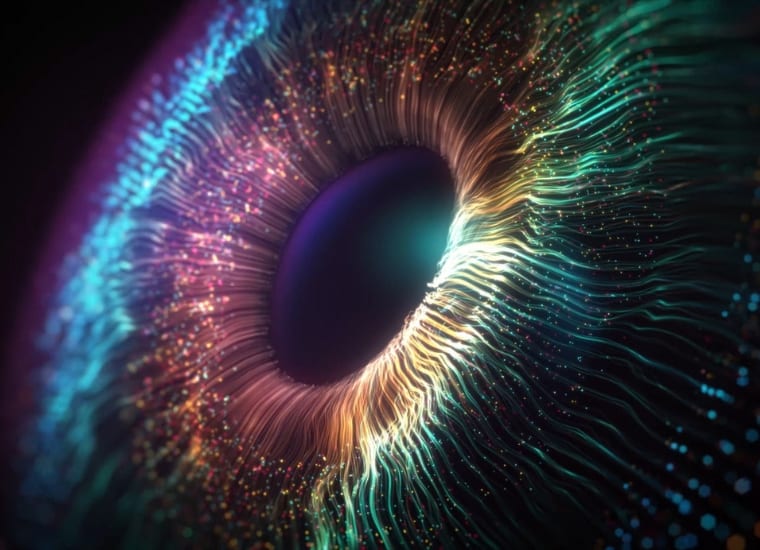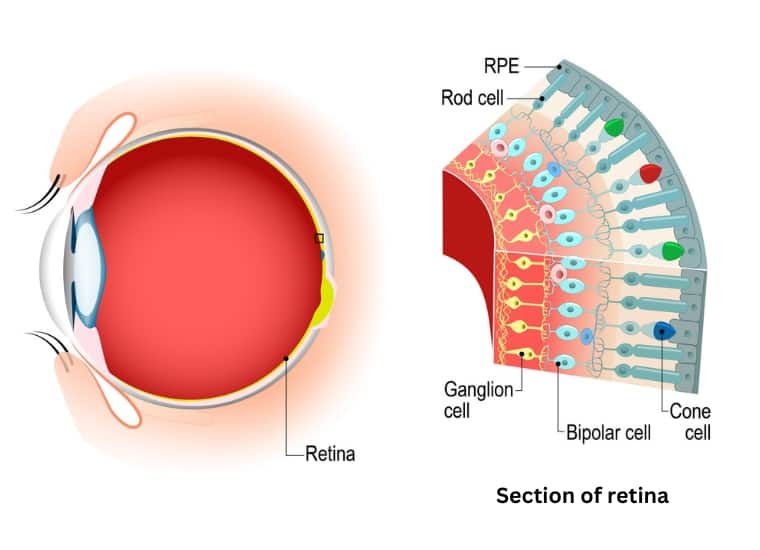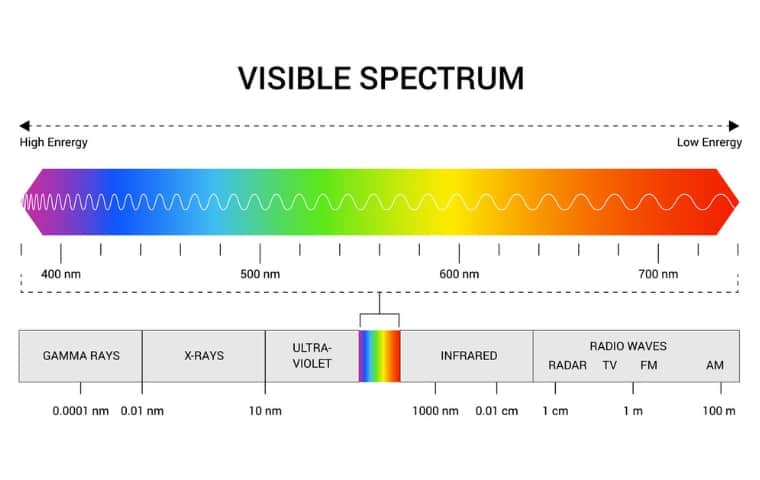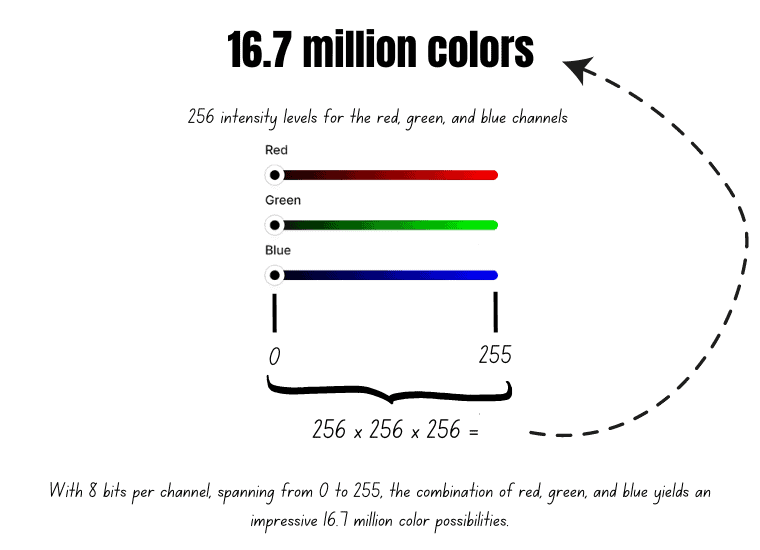Wondering how many colors are there in the world? In today’s article, we will discuss how many colors are in the world and how many colors humans can see.
The anatomy of the eye and the way human vision perceives color affect the number of colors that people with healthy vision can perceive. And certainly, the number of colors in the world exceeds the number of colors humans can perceive.
However, the math behind it will clarify things.
Wondering how many colors exist? Certainly more than the human eye can perceive.
How Many Colors Are in the World?
According to mathematical calculations, there are 16.7 million different colors in the world. Colors are made by combining the primary colors of light – red, green, and blue – at intensities from 0 to 255. When considering 256 variations for each of the three colors (red, green, and blue), the total number of possible combinations is calculated as 2563, resulting in approximately 16.7 million colors.
This is because the digital world is represented by the RGB color model (used in screens and digital devices), where each color combines red, green, and blue light.
Each primary color in the RGB model has an 8-bit value. The color intensity of each color ranges from 0 to 255. As a result, the number of colors is 256 (possible red values) * 256 (possible greens) * 256 (possible blues) = 16.7 million colors.
The number – 256 – is actually the 8-bit color depth or 2 raised to the 8th power. This means that for each of the three channels of the RGB model, there are 256 different shades.
Some newer technology, like HDR screens or professional digital cameras, use 10 bits or more per channel, representing over a billion colors.
The estimate of the number of colors a human eye can perceive comes from the way our eyes process color.
How do Humans perceive Color?

The human eye’s retina contains two types of photoreceptor cells located in the retina: rods and cones. Rods are responsible for gray-scale vision at low light levels, while cones are active at higher light levels and help with color vision.
But what are these cones? A healthy eye has three types of cones in the retina, each sensitive to a particular range of wavelengths corresponding to red, green, and blue light. [1]
There are three cone-cell types:
- Red-sensing cones – L (60 percent)
- Green-sensing cones – M (30 percent)
- Blue-sensing cones – S (10 percent) [2]

L, M, and S stand for the long, medium, and short wavelengths to which these photoreceptors are sensitive.
So they are sensitive (or receptive) to one of the three colors.
The colors we see result from these three types of cones detecting different amounts of light.
Thomas Young first proposed this theory in 1802, also called the trichromatic theory.
According to the trichromatic theory, the three cone types in the eye convert light into electrical signals, which are then perceived as colors.
A loss of blue-sensing cones (S) turns into blue-yellow color blindness. On the other hand, loss of M (green-sensing) or L (red light-sensing) cones leads to red-green color blindness.
But what happens next?
The brain combines the information received from each stimulated cone to perceive color. If the red and green cones are stimulated, but the blue cones are not, we might perceive the color yellow. [3]
For example, the light reflected by a banana activates the red and green cones, sending a signal to the brain – specifically the visual cortex – via the optic nerve.
Thus, the brain processes the number of activated cones, and the processing of nerve impulses results in yellow- the fruit’s color. [4]
But we’re only talking about the visible light spectrum, whose wavelengths range from about 380 to 720 nanometres.
The visible spectrum of light is divided into seven colors (the rainbow colors):
- Red: 625-740 nm
- Orange: 590-625 nm
- Yellow: 565-590 nm
- Green: 565-590 nm
- Cyan: 485-500 nm
- Blue: 440-485 nm
- Violet: 380-440 nm

Humans see only 0.0035% of the electromagnetic spectrum, which coincides with the spectrum of visible light.
People who are trichromats (who have all three types of cone cells) can see all the colors of the visible spectrum.
There are also people with aphakia – a condition that allows them to possess ultraviolet vision.
This condition is associated with a lack of a lens – due to congenital or surgical reasons.
The role of the lens is to block ultraviolet light. Thus, those with this medical condition can perceive wavelengths in the ultraviolet light spectrum, reaching up to about 300 nanometres. [5]
So they can see ultraviolet light.
In addition, some birds, reptiles, and freshwater fish can perceive ultraviolet light. They might be able to see colors that are not visible to humans. This is because they often have four color receptors (tetrachromats), which help them perceive wavelengths between 400 and 700 nm. [6]
How Many Colors Can Humans See?
According to researchers, most people can perceive about 1 million different colors. This is because humans have three types of cone cells, each of which can perceive about 100 different color shades. That means around one million different colors.
The math behind the million colors humans can perceive is that 100 color variations for each of the three cones result in 100 * 100 * 100 = 1 million different color shades.
This value has been established by various researchers, one of them being Jay Neitz – a researcher at the Medical College of Wisconsin. [7]
In addition, Gerald Jacobs published an article called ‘Evolution of Color Vision in Mammals‘ (2009), claiming that trichromats can distinguish up to 2.3 million colors. [8]
However, there is a debate here because other scientists from the American Academy of Ophthalmology believe the human eye can perceive up to 1000 lightness levels (from light to dark). If we multiply that by 100 levels of red-green and 100 levels of yellow-blue, the result is 10 million colors. [9]
In terms of variations, the human eye can perceive more variations in warm colors compared to cool colors. This is because 66% of cones process longer wavelengths – attributed to warm colors such as red, orange, and yellow.
The three types of cones mean trichromatic vision – or normal vision. Most people have trichromatic vision, meaning they have three types of cone cells responsible for color vision.
In 2010, scientists reported in the journal “Current Biology” that they had found a tetrachromat woman, meaning she had four types of cones in her eyes instead of the usual three.
According to one study, about 12% of women have a tetrachromatic vision, which means they have four types of cone cells. That means tetrachromats can distinguish up to 100 million different colors. [10]
Trichromats can distinguish about one million colors, while tetrachromats can distinguish 100 million colors. [11]
On the other hand, those who lack one type of cone cell are dichromatic (red-green color blindness) and can distinguish about 10,000 colors.
To give you an idea, color perception in most people is trichromatic because the retina of a human eye contains three types of light-sensitive cone cells. These absorb long (L), medium (M), and short (S) wavelengths of the visible spectrum.
This million colors that most humans can perceive is based on trichromatic theory, which says that the human eye perceives three colors of light – or three wavelength intervals – to which cone cells in the retina are sensitive. These wavelengths combine to create the colors of the visible spectrum.
However, color perception differs from person to person. It can be influenced by various factors such as lighting conditions, age and eye health, and even cultural and personal experiences.
Opponent Process Theory – Another Perspective on Color Vision
The opponent process theory proposes that human color perception is governed by three opposing systems, requiring four distinctive colors for characterization: blue, yellow, red, and green. These systems correspond to three opposing channels in our vision.
According to the opponent process theory, color is coded in opponent pairs such as black-white, red-green, and yellow-blue. This theory was developed by Edwald Hering in 1878.
The human eye does perceive variations in light intensity (luminance or brightness) and color variations, which in psychophysical terms are often broken down into variations along two axes: red-green and yellow-blue. [12]
According to scientists, the human eye can perceive one hundred shades of light, one hundred levels of red-green, and one hundred levels of yellow-blue.
That means 100 levels of light intensity, along with 100 levels of red-green and 100 levels of yellow-blue shades, leading to 100 x 100 x 100 = 1,000,000 unique colors.
However, color perception differs from individual to individual but can also be affected by lighting conditions. Also, with aging, the eye’s ability to distinguish colors decreases.
Colors are Colors, With or Without Names
Have you ever wondered how many color names there are?
Although there are about 16.7 million colors, only a small fraction have names. That’s because there are many more colors than the potential names people assign to colors.
People assign names to colors differently, but in most cultures, they associate them with objects, concepts, or substances, working like labels. [13]
For example, red means ‘blood’ in Sanskrit, and orange comes from the fruit of the same name. Discover a comprehensive list of color names.
We also tend to name colors after things we want to talk about.
So there is no official number of names for colors. While some cultures have more names, in non-industrialized cultures, there are fewer words for colors.
Final Thoughts on How Many Colors Are in the World
Although we perceive about 1 million colors (or up to 2.3 million), some believe we can distinguish up to 10 million, claiming we can see up to 1000 shades of light multiplied by 100 levels of red-green and 100 levels of yellow-blue – but without any scientific basis.
So, how many colors are there in the world?
When it comes to physics and light, the RGB model shows that there are 16.7 million colors, with 256 variations for each channel associated with a primary color.
For example, this image contains 16.7 million pixels, where each pixel represents a color (or a variation). It is said that humans can distinguish about 10 million color variations.

